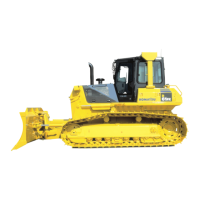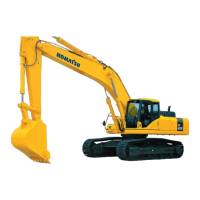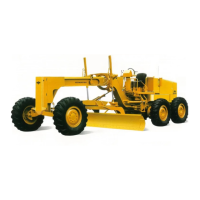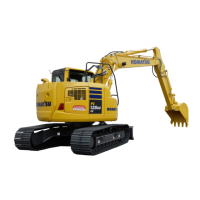COLD WEATHER OPERATION OPERATION
3-128
COLD WEATHER OPERATION 3
PRECAUTIONS FOR LOW TEMPERATURE 3
If the temperature becomes low, it becomes difficult to start the engine, and the coolant may freeze, so do as fol-
lows.
FUEL AND LUBRICANTS
Change the fuel and oil for each component to those of lower viscosity. For the specific viscosity, see “USE OF
FUEL, COOLANT AND LUBRICANTS ACCORDING TO AMBIENT TEMPERATURE (4-10)“.
COOLANT
WARNING
q Antifreeze is toxic. Be careful not to get it into your eyes or on your skin. If it should get into your
eyes or on your skin, wash it off with large amounts of fresh water and see a doctor at once.
q When changing the coolant or when handling coolant containing antifreeze that has been drained
when repairing the radiator, please contact your Komatsu distributor. Antifreeze is toxic. Do not let it
flow into drainage ditches or spray it on to the ground surface.
q Antifreeze is flammable. Do not bring any flame close. Do not smoke when handling antifreeze.
NOTICE
q Never use methanol, ethanol, or propanol-based antifreeze.
q Never use any water-leakage prevention agent or any antifreeze containing such an agent.
q Do not mix different types of antifreeze.
For details on the amount of antifreeze mixture and on when to change the coolant, see “CLEAN INSIDE OF
COOLING SYSTEM (4-23)“.
Use a Permanent Antifreeze (ethylene glycol mixed with corrosion inhibitor, antifoam agent, etc.) meeting the stan-
dard requirements as shown below. With permanent antifreeze, no change of coolant is required for a year. If it is
doubtful that an available antifreeze meets the standard requirements, ask the supplier of that antifreeze for infor-
mation.
Standard requirements for permanent antifreeze
q SAE J1034
q FEDERAL STANDARD O-A-548D
REMARK
In areas where permanent antifreeze is not available, it is possible to use antifreeze whose main component is
ethylene glycol and does not contain any corrosion inhibitor. (Such antifreeze can be used for the winter season
only.) However, in such a case, the coolant must be changed twice a year (spring and autumn), so use permanent
antifreeze when possible.

